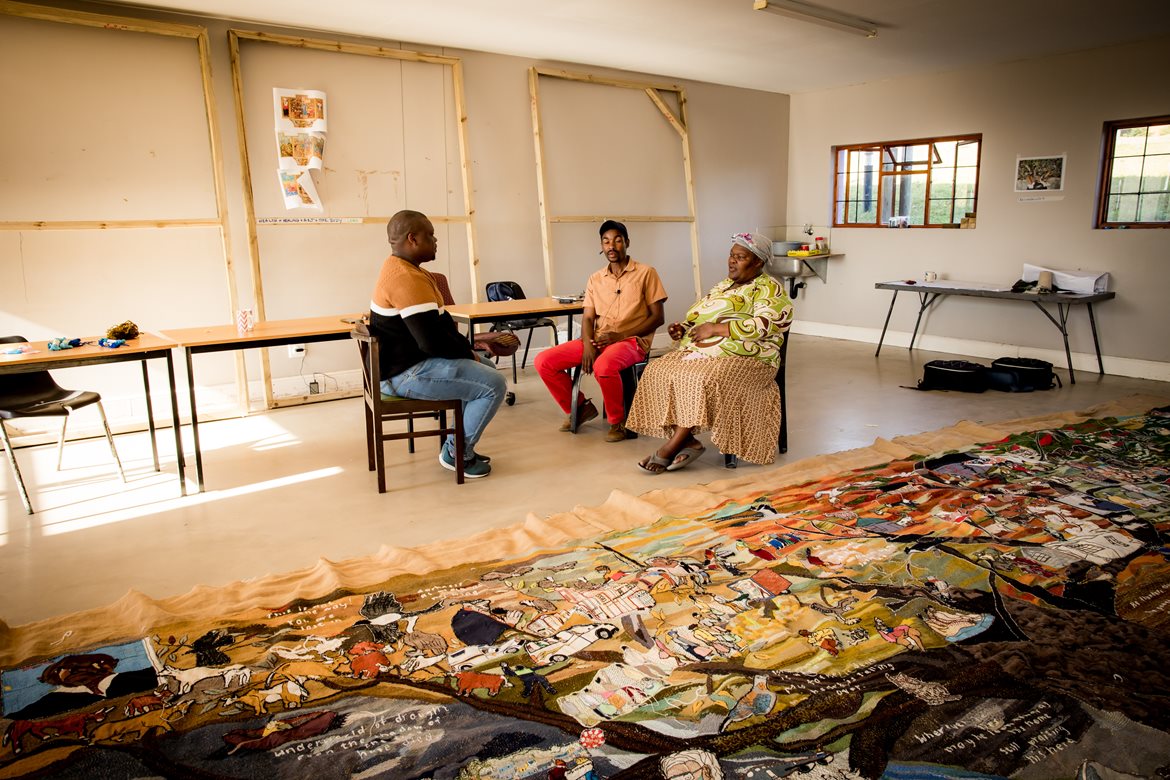One of the reasons for this disconnection might have been the slow integration of the concept of sustainability into artistic discussions and practices. In this piece, we seek to elucidate the connection between sustainability and arts, as evidenced by the tapestry work of Hamburg women.
On the field
This piece emerges from the fieldwork work we conducted as a team of researchers in the Research Chair in Ocean Cultures and Heritage. Specifically, the data and themes discussed here stem from the interviews we conducted with women and youth of the Keiskamma Trust in the village of Hamburg, Eastern Cape, South Africa.
 The women we engaged with are involved in embroidering aesthetically appealing and creatively made tapestries. These tapestries feature intricate motifs that celebrate the beauty of the rural ecosystem, including, rivers, sea, birds, plants, human beings, animals, grazing fields, South African historical figures, etc.
The women we engaged with are involved in embroidering aesthetically appealing and creatively made tapestries. These tapestries feature intricate motifs that celebrate the beauty of the rural ecosystem, including, rivers, sea, birds, plants, human beings, animals, grazing fields, South African historical figures, etc.
Sustainability through arts
In addition to the appealing tapestries, the artistic work done at the organisation can achieve sustainability in many ways. For example, when thinking through the lenses of Sustainable Development Goals (SDGs), the work of the women and Keiskamma aligns perfectly. Being involved in that artistic work has contributed to the well-being and mental health of the participants'.
One woman mentioned that she "suffered from depression and was not okay" after the passing of her mother, but when she joined the community, things began to get better.
“It is nice here; we get to chat with other women; the problems and burdens I have, I do not have to face alone.”
Drawing from these words, it is evident that art spaces are vital in promoting health and happiness by encouraging values like support, respect, unity, and collaboration. These values not only help individuals maintain a healthier and more active lifestyle but also have a positive impact on their overall well-being.
 In addition, their artwork continuously explores and produces historical, social, cultural, and natural themes grounded in the community. These artistic works serve not only as aesthetics but also as educational content that helps community members reflect on their cultural, natural, and political heritage. This continuation negates the discontinuity, which would lead to an erasure of people’s heritage, therefore “heralding the psychosocial and cultural ‘death’ of communities."
In addition, their artwork continuously explores and produces historical, social, cultural, and natural themes grounded in the community. These artistic works serve not only as aesthetics but also as educational content that helps community members reflect on their cultural, natural, and political heritage. This continuation negates the discontinuity, which would lead to an erasure of people’s heritage, therefore “heralding the psychosocial and cultural ‘death’ of communities."
Thus, it is imperative to link the connections of art and sustainability, as it has evidently proved to be beneficial to the resilience of art, sustainability and social cohesion, while recording inextricable socio-ecological settings and socio-cultural identities of Hamburg in the form of art.

References
Kagan, S., 2011. Art and Sustainability: Connecting Patterns for a Culture of Complexity (2nd emended edition 2013). transcript Verlag.
Boswell, R and Lagardien, I. 2023. The destruction of cultural heritage as a weapon of war and genocide. Daily Maverick, 19 November. Available: https://www.dailymaverick.co.za/opinionista/2023-11-19-the-destruction-of-cultural-heritage-as-a-weapon-of-war-and-genocide/